by Deep Green Resistance News Service | Apr 13, 2017 | Lobbying
by Center for Biological Diversity
TUCSON, Ariz.— The Center for Biological Diversity and Congressman Raúl M. Grijalva, who serves as ranking member of the House Committee on Natural Resources, today sued the Trump administration over the proposed border wall and other border security measures, calling on federal agencies to conduct an in-depth investigation of the proposal’s environmental impacts.
Today’s suit, filed in the U.S. District Court for the District of Arizona, is the first targeting the Trump administration’s plan to vastly expand and militarize the U.S.-Mexico border, including construction of a “great wall.”
“Trump’s border wall will divide and destroy the incredible communities and wild landscapes along the border,” said Kierán Suckling, the Center’s executive director.
“Endangered species like jaguars and ocelots don’t observe international boundaries and should not be sacrificed for unnecessary border militarization. Their survival and recovery depends on being able to move long distances across the landscape and repopulate places on both sides of the border where they’ve lived for thousands of years.”
The lawsuit seeks to require the U.S. Department of Homeland Security and U.S. Customs and Border Protection to prepare a supplemental “programmatic environmental impact statement” for the U.S.-Mexico border enforcement program.
The program includes Trump’s proposed wall as well as road construction, off-road vehicle patrols, installation of high-intensity lighting, construction of base camps and checkpoints, and other activities. These actions significantly impact the borderlands environment stretching from the Pacific Ocean to the Gulf of Mexico, which is home to millions of people, endangered species like jaguars and Mexican gray wolves, and protected federal lands like Big Bend National Park and Organ Pipe Cactus National Monument.
“American environmental laws are some of the oldest and strongest in the world, and they should apply to the borderlands just as they do everywhere else,” Grijalva said. “These laws exist to protect the health and well-being of our people, our wildlife, and the places they live. Trump’s wall — and his fanatical approach to our southern border — will do little more than perpetuate human suffering while irrevocably damaging our public lands and the wildlife that depend on them.”
Congressman Grijalva’s district is the largest Congressional district in Arizona and includes approximately 300 miles of the U.S./Mexico border.
If successful, today’s lawsuit would require the Trump administration to undertake a comprehensive review of the social, economic and environmental costs of the border wall.
Background
The National Environmental Policy Act requires that federal agencies conduct environmental review of a major federal action or program that significantly affects the quality of the human environment.
The Immigration and Naturalization Service — the precursor to the Department of Homeland Security — last updated the “programmatic environmental impact statement” for the U.S.-Mexico border enforcement program in 2001. That review identified the potential impacts of border enforcement operations, including limited border wall construction, on wildlife and endangered species in particular as a significant issue. The 2001 analysis was intended to be effective for five years but has never been updated.
In the 16 years since, the U.S.-Mexico border enforcement program and associated environmental impacts have expanded well beyond the predictions of that document, with deployment of thousands of new border agents, construction of hundreds of miles of border walls and fences, construction and reconstruction of thousands of miles of roads, installation of base camps and other military and security infrastructure, among numerous other actions.
During that same time, scientific understanding of the impacts of border walls and other border enforcement activities on wildlife and endangered species including jaguars, ocelots, Mexican gray wolves and cactus ferruginous pygmy owls has advanced significantly. The U.S. Fish and Wildlife Service has also designated “critical habitat” under the Endangered Species Act within 50 miles of the U.S.-Mexico border for more than 25 species since the outdated 2001 analysis was prepared.
Meanwhile, the number of undocumented migrants moving through the southwestern borderlands is at a historic low, and the border is more secure than it’s ever been.
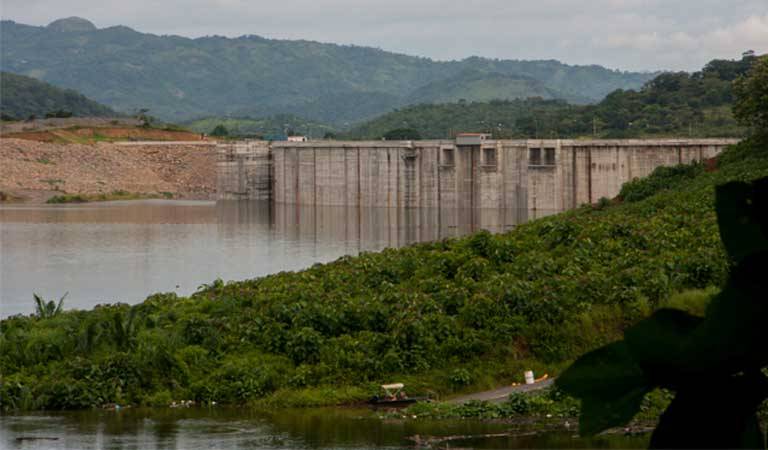
by Deep Green Resistance News Service | Apr 9, 2017 | Lobbying
Featured image: The Barro Blanco Dam in the Province of Chiriqui, western Panama. The dam is complete and will begin operation within weeks, according to the government. The Ngäbe-Bugle have been opposed to the project since its inception. Photo by Camilo Mejia Giraldo
by Tracy Barnett / Intercontinental Cry
PANAMA CITY, Panama – The waters were rising again in Weni Bagama’s community when she headed to Panama City to meet with government officials about the flooding from the Barro Blanco hydroelectric dam.
Bagama was one of 10 people scheduled to speak April 4 at the first in a series of meetings on the problem of human rights violations against environmental defenders throughout the country. The meetings were requested by the Inter-American Commission on Human Rights at a hearing on that subject last month in Washington, D.C. There are currently more than 90 recorded human rights cases related to environmental issues in Panama, according to the Ministry of the Environment.
Meanwhile, Maryknoll Sister Melinda Roper traveled to the meeting from the opposite end of Panama, the province of Darien, heading to the same April 4 meeting. She was another of the 10 people scheduled to speak.
Roper, whose wide-ranging work in Panama includes participation in a local environmental group called Alianza para un Mejor Darien (Alliance for a Better Darien), was there to speak about the government’s lack of response to the repeated threats to journalist Ligia Arreaga, who was forced to flee the country due to her reporting on the destruction of the wetlands of Matusaragatí.
More Flooding in Ngäbe Territory
The nearly two-decade fight to stop Barro Blanco has led to violent conflicts with the Ngäbe-Buglé people and drawn fire from human rights and environmental advocates internationally as an example of the misuse of carbon offset programs. Despite all of this, the dam was constructed anyway and last year the company began a “test flooding” that inundated parts of three villages.
Bagama, a leader of her native Ngäbe people and the resistance movement against the dam, continues to fight to save the villages and the Tabasará River, which is sacred to the Ngäbe. She had traveled to Washington, D.C., for the IACHR hearing on March 17, where she had taken some heart in the fact that the international commission requested the Panamanian government engage in dialogue with protesters. She attended the first follow-up meeting on April 4 with high hopes.

Sr. Melinda Roper, second from right, attended the meeting with government officials on behalf of Alianza para un Mejor Darien on April 3, where she spoke of the case of journalist Ligia Arreaga and the destruction of the Matusaragatí wetlands. Osvaldo Jordán, executive director of Alianza para Conservation y Desarrollo, is pictured fourth from the right. (Courtesy of Feliciano Santos)
Afterwards, though, she expressed frustration at the lack of a response of government officials to her pointed questions. Earlier, on March 27, some of those officials, including Vice Minister Salvador Sánchez, had traveled to her community of Kiad to begin talks with the three affected communities.
They met, but talks seemed to reach a stalemate, because residents wanted two conditions in order to move forward. First, the reservoir levels need to be lowered below the line of the autonomous territory (comarca) to allow a professional archaeological investigation of the petrogylphs that have been submerged. The petroglyphs are the Ngäbe’s most important ceremonial site and represent a crucial connection to their ancestors.
Second, they repeated their request for representatives of the Dutch and German development banks that financed the project to visit the Ngäbe communities affected by the reservoir. Bagama said she hopes that the investment banks’ presence will contribute to a workable solution. But by March 31, with no warning, the waters in the river again began to rise.
“I asked them [at the April 4 meeting], ‘How we can have a guarantee that this conversation, this approach, will have follow-through and respect when they have not even concretized anything and are filling the reservoir again?”
Bagama was told that the subject of Barro Blanco would be dealt with in a separate process. She then asked when the next meeting would take place and has not yet received an answer.

In Kiad, Panama, Weni Bagama makes her way up a hill that was once verdant, now covered in caked mud since the flooding from Barro Banco dam. (Tracy L. Barnett)
Mónica De León, director of communications for the government’s Office of Foreign Affairs, sent an institutional response to this reporter’s questions via email: “The Government of the Republic of Panama is holding talks with the representatives of the communities impacted by the Barro Blanco Hydroelectric Project, in order to promote actions that address the incompatibilities identified at the dialogue table.”
She referenced the March 27 meeting in Kiad “to agree on options for spaces and points of cultural veneration of communities impacted by the project and follow up on monitoring of water quality studies. It should be noted that the hydro has not entered operations, the test period is nearing completion and water remains at the lowest level.”
During the months-long “test period” for filling the reservoir, the community lost its generations-old food forest and most of the fish and shrimp in their river, the ancient petroglyphs that are an important ceremonial site, their roads to other communities, and several homes. In recent months the waters have dropped due to it being the dry season; the rainy season has not yet begun, so the rising waters have come as a surprise.
Barro Blanco made headlines late last year when it became the first development project to be deregistered under the U.N. Clean Development Mechanism, making the dam ineligible for issuing carbon offset credits. The Clean Development Mechanism is intended to encourage sustainable development in developing countries, but critics of the dam argued that it was anything but sustainable. Besides the fact that it would potentially displace more than 500 people and a cultural center in the comarca, the project would damage an important river ecosystem and a ceremonial and archaeological site that is vital to Ngäbe culture.
Work had continued apace on the dam despite international pressure and continued mass protests by the Ngäbe people, in which several people died and more were badly injured in confrontations with police. Now that the dam is finished and substantial parts of the communities are flooded, they fear what else will be lost in the imminent rainy season, and if the dam becomes fully operational.
There was no answer from the government regarding the request for a visit from the banks.
Paul Hartogsveld, Dutch Development Bank FMO press officer, wrote to this reporter: “FMO continues to emphasize the need for dialogue and consent between all parties involved. We respect the process and are awaiting the outcome. We do not foresee further action as this would possibly interfere with the negotiations between the government and the indigenous representation.”
A Wetlands Destroyed
Although the government has set aside 26,000 hectares of the approximately 68,000-hectare wetlands — the country’s most important — as protected area, a series of irregularities continue to plague the region, including massive land grabs by growers of industrial rice and oil palm.
Illegal canals have been constructed that are draining the wetlands, and the lagoon at its heart is beginning to run dry; 6,000 hectares belonging to the reserve have illegally been sold to private individuals, according to an ongoing lawsuit by the environmental ministry.
Roper considered the strong representation at the meeting by high officials from many government agencies, as well as the U.N.’s high commissioner on human rights, to be a good sign.
“My impression was that the atmosphere was one of clarity and openness on the part of almost all the people there to continue the process of dialog, creating a space perhaps every month for conversation to continue — realizing that there are many, many problems in Panama in terms of human rights violations, especially in relation to environmental problems,” said Roper.
“Of course it’s the type of meeting where you can make recommendations and you can establish context and dialog. It’s not a problem-solving meeting in the sense they would make a resolution to solve a specific problem, but I think it could work toward that.”
Another case presented at the April 4 meeting that continues to deteriorate, said Osvaldo Jordán, executive director of the Panamanian nonprofit Alianza para Conservación y Desarrollo (Alliance for Conservation and Development), is the development of Pedro González Island, where residents of African descent say law enforcement has arbitrarily detained them for opposing a foreign investor’s tourism project on lands they and their ancestors have inhabited for 300 years.
Despite the disappointment that Barro Blanco wasn’t addressed, attendees agreed that the meeting was a positive beginning to a new forum for addressing human rights violations against environmental defenders.
“I think it was positive in the sense that it allowed for a dialog,” said Jordán. “These are groups that were heavily oppressed, and their cases were ignored. So just making those cases visible and raising them to this level of public awareness is a step ahead. Unfortunately no clear answers were given and the danger is that this becomes catharsis — just a time for people to vent their frustrations without getting to any resolution. So we have to fight hard for that not to happen.”
Farah Urrutia, Director of the Ministry of Foreign Affairs, responded to this reporter’s questions in an email, referencing the achievements of the meeting: the presence of high-level officials in various government agencies, as well as the Office of the Ombudsman, and an agreement to follow up with site visits to the problem areas and by organizing monthly meetings with environmental defenders.
“Finally, we believe that the climate of the [working group] is conducive to assess the possible presentation of a bill that can protect these groups,” she added.
Jordán agreed. “I think the meeting represented a positive direction, in particular the proposal of the ombudsman’s office to coordinate with the U.N. in trying to get a policy that will protect environmental defenders in Panama,” he said.
Meanwhile, Bagama is hopeful of receiving a phone call soon so that the conversations with the government can continue. Although she clarified — as she did at the April 4 meeting — that in her view, as of yet there is no formal dialog between the communities and the government, and there will be no dialog until their requests are met.
“If the government wants a conversation with the affected communities, they need to stop filling the reservoir,” she said. “If they do not stop the filling it, there is no conversation. It is regrettable and I don’t want it to happen, but that is what will happen if the government does not order to stop filling. They argue that they cannot do it, but I ask, ‘Who is in charge? The government or the companies? Who defends the rights?’ That is what we are seeing.”
[Tracy L. Barnett is an independent writer, editor and photographer specializing in environmental issues, indigenous rights and sustainable travel.]
An earlier version of this story appeared in Global Sisters Report.
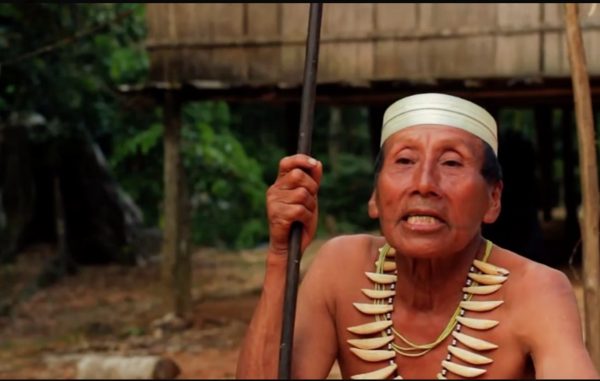
by Deep Green Resistance News Service | Mar 15, 2017 | Indigenous Autonomy, Lobbying
Featured image: Salomon Dunu, a Matsés man who survived the trauma of first contact, speaks to a Survival campaigner about the threat of oil exploration to his people. © Survival International
by Survival International
A Canadian oil company has told Survival International it will withdraw from the territory of several uncontacted tribes in the Amazon where it had been intending to explore for oil.
The company, Pacific E&P, had previously been awarded the right to explore for oil in a large area of the Amazon Uncontacted Frontier, a region of immense biodiversity which is home to more uncontacted tribes than anywhere else on Earth. It began its first phase of oil exploration in 2012.
The move follows years of campaigning by Survival International and several Peruvian indigenous organizations, including AIDESEP, ORPIO, and ORAU. ORPIO is suing the government over the threat of oil exploration.
Thousands of Survival supporters had protested by sending emails to the company’s CEO, lobbying the Peruvian government, and contacting the company through social media.
Survival also released an open letter, protesting against the threat of oil exploration, which was signed by Rainforest Foundation Norway and ORPIO. Sustained campaigning helped bring attention to the issue within Peru and around the world.

The Matsés have been dependent on and managed a large area of the Amazon Uncontacted Frontier for generations. © Christopher Pillitz
In a letter, Pacific E&P’s Institutional Relations and Sustainability Manager said that: “[The company] has made the decision to relinquish its exploration rights in Block 135… effective immediately… We wish to reiterate the company’s commitment to conduct its operations under the highest sustainability and human rights guidelines.”
At a tribal meeting in late 2016, a man from the Matsés tribe, which was forced into contact in the late 20th century, said: “I don’t want my children to be destroyed by oil and war. That’s why we’re defending ourselves… and why we Matsés have come together. The oil companies … are insulting us and we won’t stay silent as they exploit us on our homeland. If it’s necessary, we’ll die in the war against oil.”
Oil exploration involves sustained land invasion which can dramatically increase the risk of forced contact with uncontacted tribes. It leaves them vulnerable to violence from outsiders who steal their land and resources, and to diseases like flu and measles to which they have no resistance.
The announcement that it was not going ahead was welcomed by campaigners as significant in the fight to protect uncontacted peoples’ lives, lands and human rights.
Survival’s Director Stephen Corry said: “This is great news for the global campaign for uncontacted tribes and all those who wish to halt the genocide that has swept across the Americas since the arrival of Columbus. All uncontacted peoples face catastrophe unless their land is protected and we believe they are a vitally important part of humankind’s diversity and deserve their right to life to be upheld. We will continue to lead the fight to let them live.”
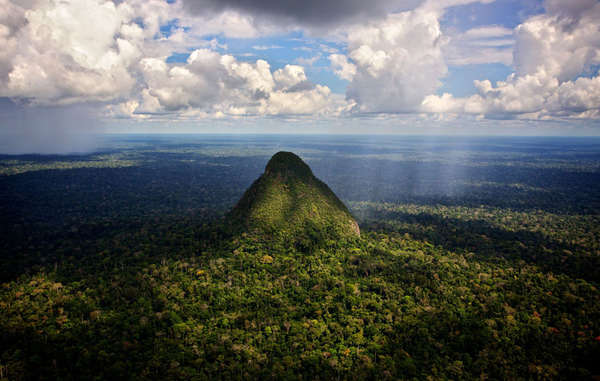
The region includes the Sierra del Divisor, or “Watershed Mountains,” a unique and highly biodiverse region known for its cone-shaped peaks. © Diego Perez
Background briefing
▪ Oil block 135 is within the proposed Yavarí Tapiche indigenous reserve. Peru’s national Indian organization AIDESEP has been calling for the creation of the reserve for over 14 years.
▪ Part of the oil concession is within the newly created Sierra del Divisor national park. The Peruvian government had awarded Pacific E&P rights to explore within the park.
▪ The Yavarí Tapiche region is part of the Amazon Uncontacted Frontier. This area straddles the borders of Peru and Brazil and is home to more uncontacted tribes than anywhere else in the world.
▪ Peru has ratified ILO 169, the international law for tribal peoples, which requires it to protect tribal land rights.
▪ We know very little about the uncontacted tribes in the area. Some are presumed to be Matsés, but there are other uncontacted nomadic peoples in the region.
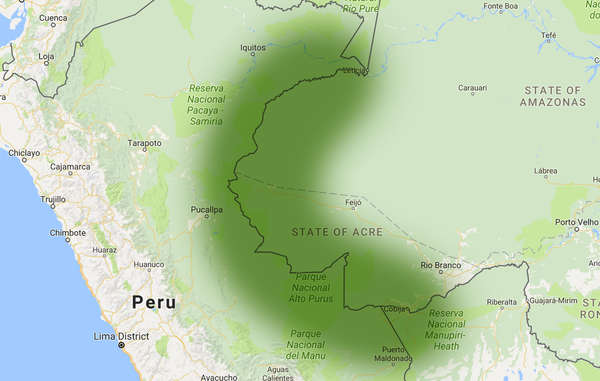
The Amazon Uncontacted Frontier, a large area on the Peru-Brazil border that is home to the highest concentration of uncontacted tribes in the world. © Survival International
Uncontacted tribes are not backward and primitive relics of a remote past. They are our contemporaries and a vitally important part of humankind’s diversity. Where their rights are respected, they continue to thrive.
Their knowledge is irreplaceable and has been developed over thousands of years. They are the best guardians of their environment. And evidence proves that tribal territories are the best barrier to deforestation.
All uncontacted tribal peoples face catastrophe unless their land is protected. Survival International is leading the global fight to secure their land for them, and to give them the chance to determine their own futures.
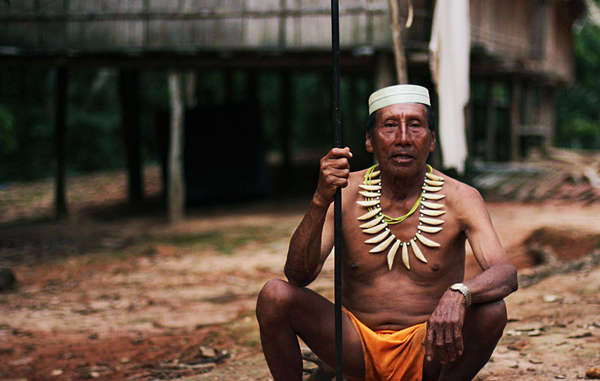
by Deep Green Resistance News Service | Mar 10, 2017 | Lobbying
Featured image: The Matsés have denounced oil exploration in the proposed Yavarí Tapiche reserve, which is part of their ancestral lands. © Survival International
by Survival International
In an open letter to the Peruvian authorities, Survival International, Rainforest Foundation Norway and Peruvian indigenous organization ORPIO have denounced the Peruvian government’s failure to protect uncontacted tribes.
The organizations are calling for the government to create an indigenous reserve, known as Yavari-Tapiche, for uncontacted tribes along the Peru-Brazil border, and to put a stop to outsiders entering the territory.
In the letter the three organizations state: “Uncontacted tribes are the most vulnerable peoples on the planet. They have made the decision to be isolated and this must be respected…
“The Yavarí Tapiche region is home to uncontacted peoples. Despite knowing of their existence and enormous vulnerability, the government has failed to guarantee their protection…
“These tribal peoples face catastrophe unless their land is protected. Only by creating the proposed Yavarí Tapiche indigenous reserve and implementing effective protection mechanisms that prevent the entry of outsiders, will the indigenous people be given the chance to determine their own futures…
“We are also concerned about the government’s refusal to exclude oil exploration within the proposed reserve…. No exploration or exploitation of oil should ever be carried out on territories inhabited by uncontacted Indians…
“We believe that the oil company Pacific Stratus is poised to begin operations this year in areas where there are uncontacted tribes…
“By failing to both create the reserve and to rule out oil exploration, Peru is violating both domestic and international law…
“If the government does not act urgently to protect the uncontacted peoples of Yavarí Tapiche, we fear that they will not survive. Another tribe will disappear from the face of the earth, before the eyes of the world.”
Survival’s Director Stephen Corry said: “We’ve repeatedly called for the Yavarí-Tapiche indigenous reserve to be created and for oil exploration to be ruled out, but the government has dragged its feet. The lives of uncontacted Indians are on the line but once again, economic interests take priority.”
Background Briefing
– The Yavarí Tapiche region is part of the Amazon Uncontacted Frontier. This area straddles the borders of Peru and Brazil and is home to more uncontacted tribes than anywhere else in the world.
– Pacific Stratus, part of Canadian oil company Pacific E&P, began its first phase of oil exploration in 2012, despite protests from indigenous organizations and Survival International. It is believed that the company will begin its second phase soon.
– Oil exploration is devastating for uncontacted tribes. Over 50% of the Nahua tribe died as a result of exploration in the 80s.
– The indigenous organization ORPIO is suing the government over the threat of oil exploration.
– National indigenous organization AIDESEP has been calling for the creation of the reserve for over 14 years.

by Deep Green Resistance News Service | Feb 19, 2017 | Education, Movement Building & Support
by Erin Moberg / Deep Green Resistance Eugene
On Saturday, February 4th, several members of DGR Oregon attended a day-long NVDA training in Eugene, Oregon. The event was organized by local and regional activists. Over 200 people attended, including local activists, community members new to direct action, college students, youth, retired people, and others from nearby towns.
DGR members attended this training as part of an increased effort to connect with Eugenians from other activist groups and to invite community members to two upcoming events: (1) a DGR Open House in downtown Eugene (March 8) and (2) an Advanced Direct Action Training to be held just outside of Eugene over Earth Day weekend (April 22-23). We also, of course, wanted to see what we could learn.
The Keynote Speaker was Leonard Higgins, who shared a short film documenting his experience as one of the “valve turners” who shut down oil pipelines in five states in October of 2016. Higgins described direct action as “not the only important work to be done” but crucial in that it supports other activist work, including: changing the economy, transitioning to alternative energies, and expanding community organizing strategies. Although his remarks and the entire training focused on “preserving life as we know it and civilization” and “ensur[ing] a future for human civilization,” Higgins and the film did help to normalize and demystify direct action for those new to environmental activism.
People who want to support the valve turners can attend a legal costs fundraiser event on the evening of February 24th at 6:30pm at the First Methodist Church near downtown Eugene. The suggested donation for the event is $20, but no one will be turned away for lack of funds.
The workshops (Medic Training, Encryption Basics, Jail/Arrest Support, Action Planning, “Artivism,” and more) emphasized peaceful resistance toward the end of sustaining or bettering life for human beings. Even when referencing the Water Protectors at Standing Rock, there was no concrete mention of the destruction of the land and little reference to the occupation of indigenous communities and territories by the culture of empire. While this may be simple omission, it’s a trend in mainstream activist groups—especially in predominantly white groups—to avoid naming the problem, and to avoid being “negative.”
Most frustrating in the workshops was the lack of organization and structure; many facilitators had poor presentational skills, little understanding of key semantic nuances of relevant terminology (ie: violence, use of protective force, and violation), and an overall lack of consciousness around anti-oppression strategies necessary to foster equitable engagement and collaborative environments.
This is unsurprising, as in our experience mainstream activist groups and NGOs such as this often serve as a sort of buffer against truly revolutionary change by funneling energy, donations, and volunteers into minor reforms.
In the workshop on Action Planning, the facilitator (a Portland-based activist) did share several strategies that could be useful for DGR meetings, direct action trainings, and forum culture. One is the acronym WAIT/WAINT (Why Am I Talking? / Why Am I Not Talking?), a variant of the Step Up/Step Back framework designed to encourage those who occupy positions of privilege and tend to dominate (white people, men, documented folks, etc.) to hold space for those whose voices and experiences are often silenced or ignored (people of color, women, undocumented folks, etc.). She also explained the “Points of Intervention Model” as way for activists to identify how, where, and when to plan a concrete direct action. This model asks organizers to consider points of production (ie: labor site), destruction (ie: mines), consumption (ie: households), decision (ie: corporate head), assumption (ie: segregated spaces), and potential before then deciding on:
- vision –> (2) campaign–> (3) strategy–> (4) tactic–> (5) action
Her example was:
- Stop climate change–> (2) Halt proposed pipeline construction–> (3) pass anti-pipeline legislation–> (4) forums, petitions, lawsuits–> (5) Not specified during the workshop
While the training was a good first step for first-time activists interested in learning more about political organizing, this day of workshops didn’t provide a compelling vision of the application of political power. For those with little to no activist experience, there were no clear articulations of the history, potential, and goals of direct action. For those who attended as experienced activists, there were no hands-on workshops offered for specific direct action skills trainings (ie: how to build and use lockboxes). The legal presentations, encryption info, and medic training did offer concrete skills that are valuable to organizers. In terms of community representation at this event, there were no facilitators of color, few female facilitators, and few opportunities designed to connect training participants one-on-one.
Overall, this training focused on issues leading up to or arising in the aftermath of direct actions, not the actions themselves. For organizing large groups to achieve reforms, it was a potentially useful training. However, for people interested in deep revolutionary changes, it was lacking.
Thanks to the organizers for hosting this event.
People interested in learning more advanced skills should contact DGR Eugene to inquire about our advanced direct action training scheduled for Earth Day weekend, April 22-23.
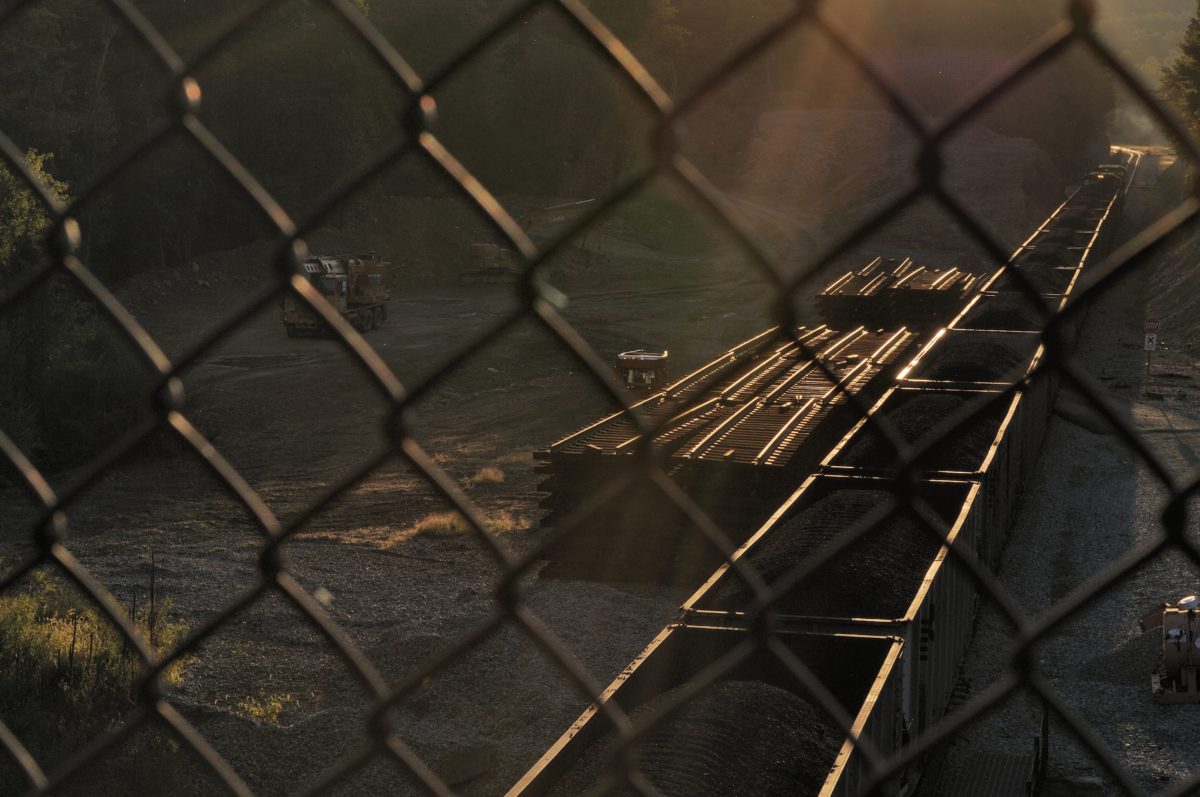
by Deep Green Resistance News Service | Feb 3, 2017 | Lobbying
by Community Environmental Legal Defense Fund
Today, Spokane activists, including several who were arrested for blocking fossil fuel trains in Spokane four months ago, filed suit against the federal government in the United States District Court for the Eastern District of Washington.
The lawsuit, known as Holmquist et. al. v. United States, asserts that the federal law preempting city health and safety laws over fossil fuel rail shipments violates residents’ constitutional right to a healthy climate and local self-government.
This is a first-of-its-kind case directly challenging federal preemption as an infringement of constitutional rights when that preemption operates to prohibit the passage of health and safety laws at the municipal level.
The lawsuit comes on the heels of a recent federal court decision in Oregon which recognized that people possess a fundamental constitutional “right to a liveable climate” pursuant to the due process clause of the United States Constitution.
In that case, Kelsey Cascadia Rose Juliana v. United States, Civ. No. 6:15-cv-01517 (November 10, 2016), Judge Ann Aiken of the U.S. District Court for the District of Oregon wrote, “I have no doubt that the right to a climate system capable of sustaining human life is fundamental to a free and ordered society. . . to hold otherwise would be to say that the Constitution affords no protection against a government’s knowing decision to poison the air its citizens breathe or the water its citizens drink.”
Plaintiffs in the Spokane lawsuit include Dr. Gunnar Holmquist, the primary sponsor of a City of Spokane citizen-sponsored initiative to ban coal and oil trains due to climate change. Additional plaintiffs are Rusty Nelson, Nancy Nelson, Margie Heller, Deena Romoff, George Taylor, and G. Maeve Aeolus, each of whom was arrested in August and September 2016 actions for blocking fossil fuel trains. The plaintiffs are being represented by Lindsey Schromen-Wawrin, a lawyer with the Community Environmental Legal Defense Fund.
Dr. Holmquist, the lead plaintiff in the litigation, declared, “Now is the time to step forward to do everything possible to stem the global crisis of climate change. This lawsuit will inevitably be the first of many which seek to begin to align state and federal laws with the realities of global warming – liberating communities to begin to take the difficult steps necessary for our continued survival on this planet.”
The federal lawsuit coincides with the re-filing of an initiative within the City of Spokane to amend the City’s home rule charter. The initiative would recognize a “right to a healthy climate” and ban fossil fuel trains as a violation of that right. Supporters of that initiative are preparing to collect signatures to qualify the initiative for the November 2017 ballot.
About CELDF — Community Environmental Legal Defense Fund
The Community Environmental Legal Defense Fund is a non-profit, public interest law firm providing free and affordable legal services to communities facing threats to their local environment, local agriculture, local economy, and quality of life. Its mission is to build sustainable communities by assisting people to assert their right to local self-government and the rights of nature.
Featured image: Steve Tatum, Flickr Creative Commons – Coal Train. View from the footbridge on the Huckleberry Trail crossing the Norfolk Southern tracks.










